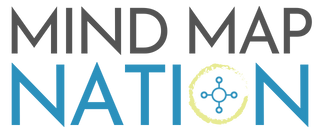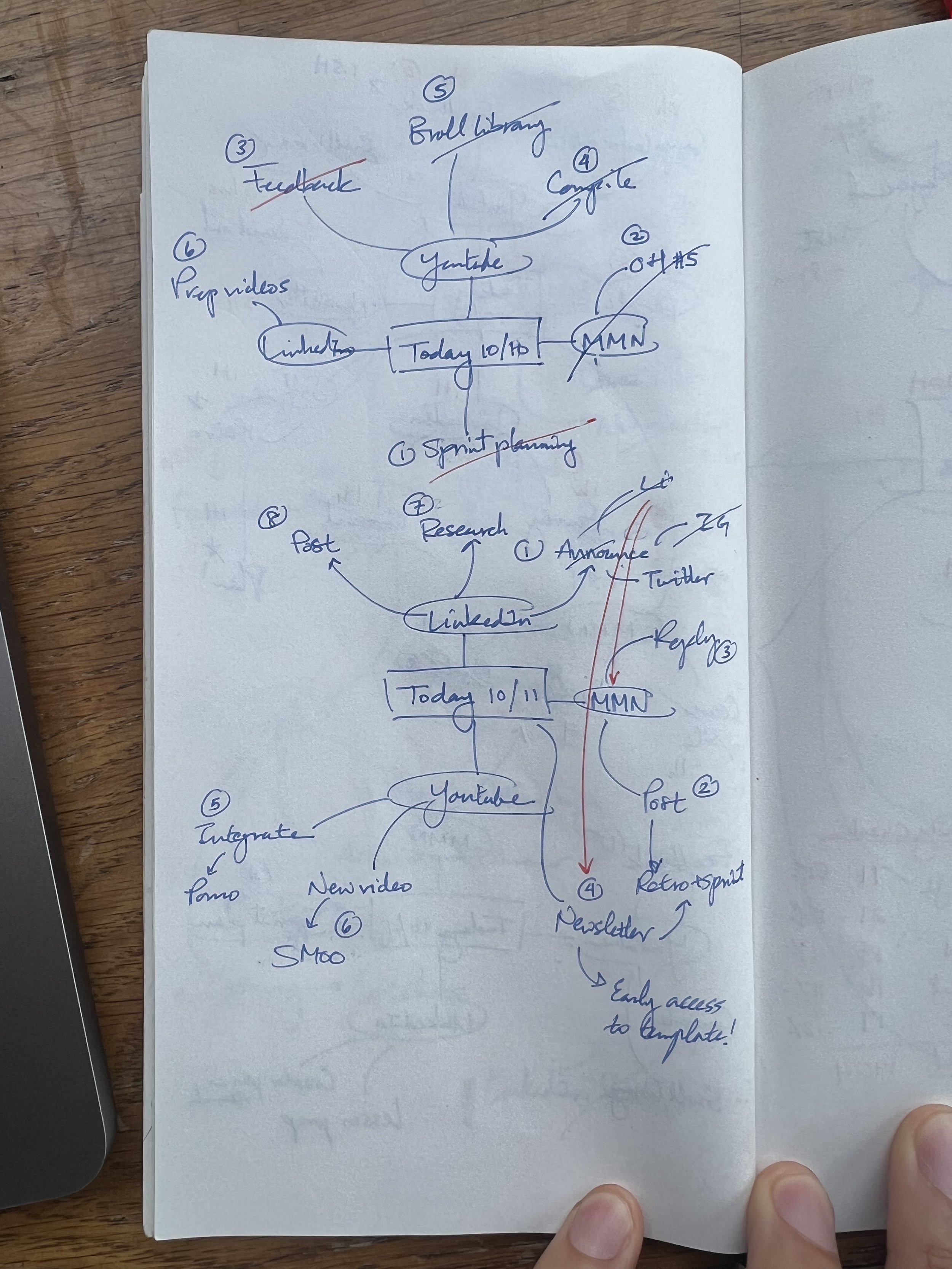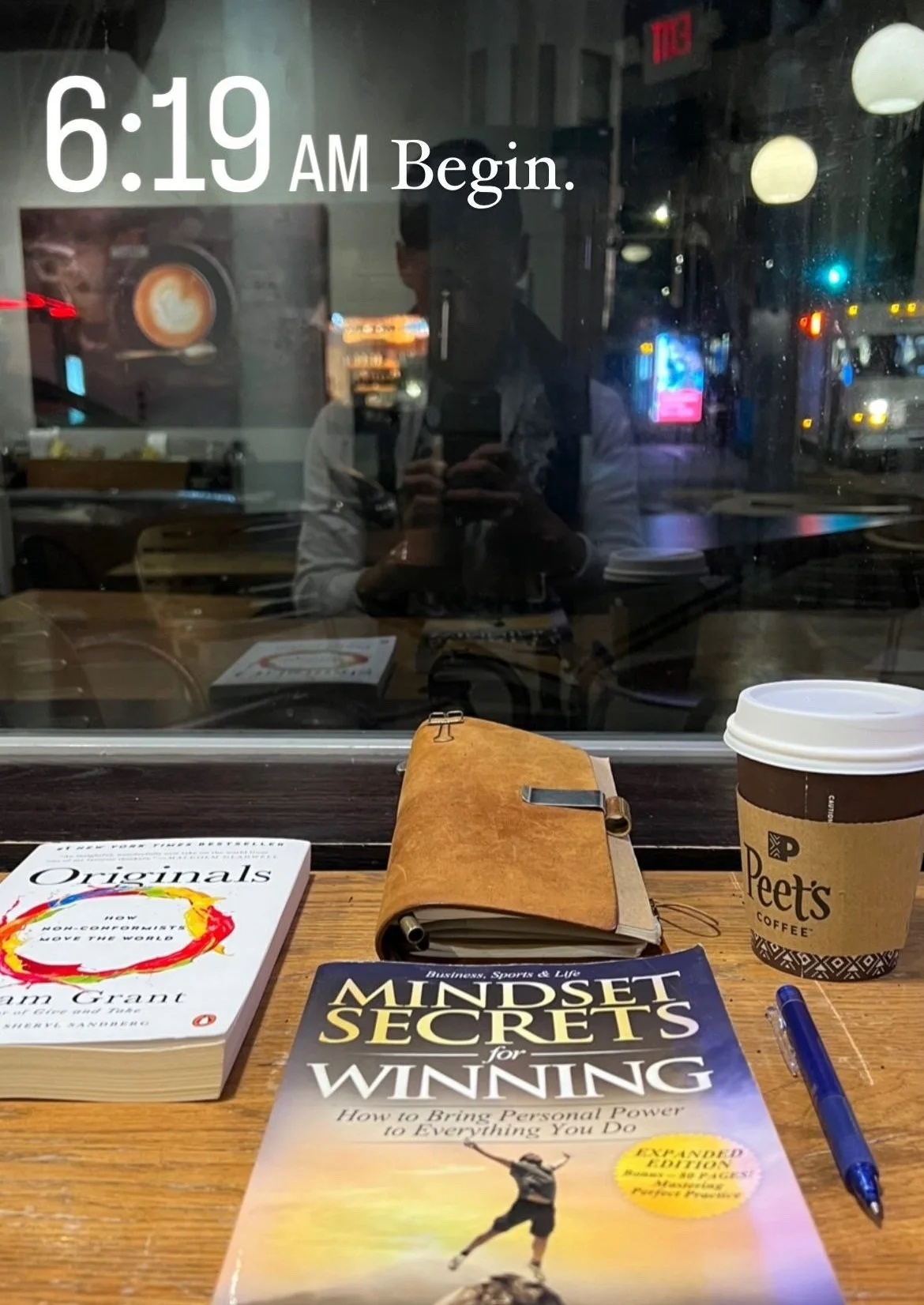How to Systematically Upgrade Your Productivity
Your productivity and performance doesn’t have to be guess work. It should be treated like an intentional system.
I started running my life in 2-Week Sprints during quarantine to build structure into my daily routine as the world shut down.
Since then, I've used the system to build 3 websites, launch my coaching practice, produce 60+ YouTube videos and write 30+ articles. It’s also helped thousands of people around the world jumpstart their own projects.
I upgraded this system a few months ago by incorporating a custom-built Notion table to track my performance in Pomodoros (25 minute increments) and record daily retrospectives. This little add-on turned out to be instrumental in keeping me hyper focused and productive in launching my most ambitious project yet: Mind Map Nation (MMN).
In this article, I'll show you my end-to-end process of using this powerful tool to enhance your own performance using my 9/19-10/2 Sprint as the example. This particularly intense Sprint rebooted my YouTube video production and launched MMN's 7-day Mind Map course, so there's a lot to cover.
What are 2-Week Sprints and Retrospectives?
I've made a primer and walkthrough if you're unfamiliar with my 2-Week Sprint system.
In short, it’s adapted from the Agile framework used by top tech companies like Google and Meta to make $billions through incremental improvements while maintaining high productivity and focus. Combined with the Bucket List (or Life Road) Map, this technique chunks big ambitious goals into manageable short projects by:
1) Focusing on just 3-4 areas
2) Setting SMART (Specific, Measurable, Actionable, Realistic, Time-framed) goals
3) Building momentum by achieving small goals in the beginning
At the end of each 2-Week Sprint is the Retrospective, which reviews our Sprint's performance and orients the direction we're taking our projects.
The questions you should be asking during the Retro are:
1) What went well?
2) What didn't go well?
3) How we can improve?
4) What we should discontinue?
The Retrospective is both the end of the last Sprint the first step in the next cycle of goal discovery and execution.
Alright, let's go through my process.
Step 1: Review Sprint Map
I go through my previous Sprint map (this article shows how I break down my 3-month quarterly goals into 2-week Sprints) and green circled the goals that I succeeded in and red crossed the ones that I didn't. This tells me at a glance how well I did.
Step 2: Review Sprint Tracker
Next I review my Sprint Tracker to analyze the granular qualitative (Daily Retros) and quantitive (Pomodoro counts) data. You can copy the Notion template here. I've also linked my full tutorial for this tracker in the "Hot Off the Press" section.
I then mind map the takeaways from the tracker:
The mind map is usually enough for me to understand where I need to improve, but here's the breakdown of key metrics and insights:
Productivity rating: I had 8 Great days, 5 Good days, 1 Poor day. This is a pretty good record for me. I've had worse sprints before.
I then look for patterns in my Daily Retro column:
Great days generally had early wakes, self-care activities, less time spent around the house, filming sessions, and focused meeting followups.
Good days had poor sleep, more social obligations, errands and long lunch breaks.
Poor days had unexpected social engagements and heavy distractions.
I averaged 19 daily Pomodoros equivalent to 9.5 focused hours (two Pomos = 1 hour). This is a very high number. For comparison, a full working day is 10-12 Pomos. This explains why my Productivity rating's so high. On the flip side, I was exhausted (but happy) by the end.
I spent a total of 135 hours on 4 Focus Areas. "EST" is what I estimated in my Sprint Map (step 1), "GOAL" is what I estimated in my Daily To-do Map and inputed into the Tracker's Goal column, "ACTUAL" is what I actually did:
MMN (20%): I estimated 62 Pomos, or 31 hours, in the Sprint Map, but when it came to daily planning it came down to 53 Pomos, which I completed. This equates to ~26 hours or 2 hours per day.
Creation - YouTube, writing, hiring (39%): Estimated 102 Pomos (51 hours), ended up needing 126 Pomos (63 hours), but only delivered on 106 Pomos or ~4 hours per day. I underestimated creation related time by over 10 hours because there are so many steps to creating each video and newsletter. The topics themselves were also quite complex. I didn't deliver on my planned Pomos because I got wrapped up in too many unplanned social engagements.
Social - Non-MMN Meetings, events, friends (17%): My lesson is that if I'm not aware, I'm prone to blowing past it. This is exactly what happened. I just left social as a "?" on my Sprint Map, and ended up planning 31 Pomos at the daily level, and actually exceeded it by 50% at 46 Pomos (or 23 hours)! Coincidentally, this difference closely matches how much I missed my Creation goals by. Hmmm...
Self - Meditation, exercise, reading (24%): While I didn't meet my estimated 84 Pomos, I'm actually proud of my consistency with self-development activities. 64 Pomos (32 hours) or 24% of my time allocation seems about right too.
Other key Insights
Given that the focus of this Sprint was MMN and Creation, I ended up saying 'yes' to too many social things, which squeezed me on the Creation side. While I achieved most of my goals, it was a desperate sprint towards the end to finish everything! Stressful but rewarding.
I learned that my Productive Capacity is around 135 hours (the sum of all my ACTUAL Pomos) across 2 weeks. This is an important insight that will help me budget for the next Sprint.
Step 3: Kaizen (Continuous Improvement)
Finally, I map the good, bad, and improvement points from the last Sprint. Again, the mind map is usually enough for me to plan the next Sprint, but I've listed the insights below.
The Good
Despite eating into my time, the social engagements were fun (for the most part) 🙂
I finished all the newsletters and videos I had planned!
MMN is freaking awesome. I love our community challenge and office hours!
This is the first Sprint where I hit almost all my self development goals - yes! Cold showers + Wim Hof breathing were added bonuses.
I also hired a new editor which will make my life easier going forward.
The Bad
While I hit my creation goals, I didn't distribute my content over platforms like LinkedIn, IG, and Twitter. I've always been terrible at this, so it didn't help that I was squeezed for time.
Again, too many last minute social things that added tons of switching costs on top of going to the events themselves.
I didn't have time to hire a designer.
Improvement points
To reign in my social activities, I'm going budget for them this time. For spontaneous stuff, I need to go by feeling: if it's not a 'hell yeah!' it's a 'no'.
Since most of my Great days have early starts, I need to prioritize sleep and get up early.
I'm most productive when I'm working at a cafe, so I need to meal prep to reduce the time I stay in the house or set a timer for when I'm indoors for lunch.
Discontinue
This is my gauge on whether I want to stop pursuing something I didn't like during the last Sprint. This time I'm going to continue everything. While social did hold me back, I don't want to be a hermit either, so it's about reduction rather than discontinuation.
Step 4: New Sprint Planning
Now that we've gone through the last Sprint's retro, it's time to rev the engine for the new one. The last Sprint took so much out of me that I took it easy for 2 days and spent the remaining 5 days working without the Tracker.
It's important to have a break in between intense sprints to avoid burnout.
The focus areas are Create, MMN, Social, and Self to match my Tracker. The fourth focus area is Optionality which creates a buffer for opportunities that might arise like workshops and coaching.
This Sprint is even more intense than the last one. From my retrospective, I determined that my Productive Capacity is around 135 hours, so I'm pushing it to 140 hours this time (see Sanity Check).
The 500-pound gorilla is Create, which is heavily dedicated to the LinkedIn Creators Accelerator Program. It involves a 6-video series plus meetups like the ones we have at MMN.
On the YouTube side, it's about working with my new editor to get through the videos I filmed during the last Sprint. I also need to hire an assistant to help with summarizing MMN meetings and distributing my content across social platforms. Of course, there's also this newsletter to write!
MMN's time commitment is a bit lower this Sprint because we just finished our 7-day course. On top of our regular office hours and followup, I'm organizing a special topic meetup on Traveler's Notebooks.
I'm reducing Self activities by ~30% and instead going for consistency. My experience is that if I'm consistent, there's a good chance I'll actually extend the activity. For example, if I commit to reading 30 minutes a day, I'll likely continue reading for another 30 minutes if I'm in the flow. Even if I don't, those 30 minutes add up over time. The important part is to show up.
Finally, we've got Social - the boogeyman of the last Sprint. Instead of assigning an estimate, I added up all the other focus areas' estimates and subtracted it from my Productive Capacity of 140 hours. It came out to be 16 hours or ~30% decrease from my last Sprint.
There you have it. The first few Daily To-do maps & Tracker looks like this:
Yeah...I woke up randomly at 3:30am on day 2. Oh well...that's what emergency ☕ is for! 👊
I’m now incorporating Interstitial Journaling to my Daily Retros. Instead of doing the retro at the end of the day, I'm documenting my last and next actions. This mental continuity dramatically reduces my switching costs. Thanks to our MMN member Chris Rodgers for this tip! 🙏
To summarize, the main benefits of using the Pomodoro Technique with this tracker are:
1) Understand how our daily to-do's contribute to the bigger picture of our life goals and priorities.
2) Kicks us into flow and keeps us there.
3) Time is our most valuable resource, so we should be aware of how our time is spent. I'm not suggesting we live life constantly in 25-minute blocks, but it's helpful to know that everything we do have opportunity costs.
📺 Hot Off the Press: Full Pomodoro Tracker Tutorial
If you want a deep dive into the Sprint Pomodoro Tracker, look no further (excuse the stern look...I'm trying to convey focus with purpose 😆):
In this video, I'll show you how to turn these humble 25-minute blocks into your engine for intentional productivity.
Make the most of your mind maps
Thanks for reading this article. If you found it useful, you can get a new mind map in your inbox every week. Epiphany is your dose of structured thinking and ordered chaos.




